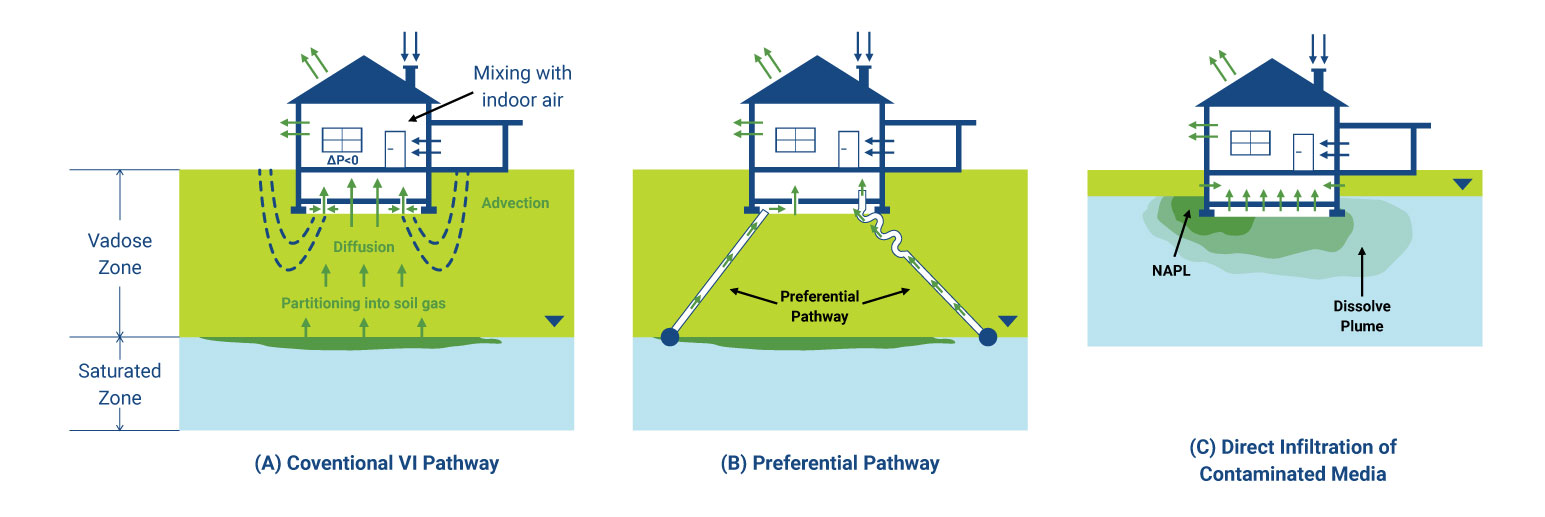
Here’s How Vapor Intrusion Can Impact You
1. What is Vapor Intrusion?
Vapor Intrusion (VI) is the diffusion of volatile chemicals from contaminated groundwater or soil into buildings and the environment. As the diagrams below show vapor intrusion can find three different pathways into buildings or into the air above a field. The concentration of these volatile compounds will vary depending on a lot of factors but will tend to be greater with a preferential pathway and greatest with direct infiltration of the contaminant. None of these pathways are good for the home or business owner or for inhabitants or workers in the scenarios below. At any site that is contaminated with volatile organic compounds (VOCs), soil vapor intrusion is considered the most likely pathway to human exposure.

Since the 1990’s when the US became aware of the danger posed by dumping sites of VOCs through soil vapor intrusion, much attention has gone to limiting the human risk of exposure to these sites. The EPA began extensive research into limiting and regulating the use of VOCs and protecting people from exposure to them in any way.
- The Conventional VI pathways into overlying structures is that volatile organic compounds in the ground or groundwater begin to partition into gases that diffuse through the soil below these structures. These gases will build up below the foundation of a structure until they find cracks in the foundation or walls and seep into the building itself.
- Preferential VI pathways allow the escaping gases to use subsurface conduits such as sewer lines, storm drains, cable ducts or utility lines to serve as highly permeable gas pathways into buildings.
- Direct Infiltration of VI into buildings can occur when the structure itself is built on land contaminated with VOCs or over a fluctuating water table that occasionally floods and is in direct contact with a VOC contamination. In these cases VI will infiltrate the building(s) directly since the chemicals saturate the structural foundation and even the walls themselves..
2. Indicators that Vapor Intrusion is affecting a property
The first indicator, and the most obvious one, is the presence of vapor intrusion chemicals on the site itself as product, cleaning supplies, ingredients for products made, etc. When volatile organic compounds are stored on site there is always the risk of vapor intrusion from unsealed or cracked containers, spills, underground storage tanks, or from paints used on building walls or on equipment.
A second indicator which will result in VI is the presence of preferential pathways into the building. Are there sewer lines below the building, mine shafts nearby, fractures in the foundation, tunnels, lots of conduit for cables where gases can easily diffuse into the building?
A third indicator is the presence of risk factors already inherent in your structure. These include a low and fluctuating water table, known sources of VOCs in the vicinity and /or changing pressures inside or below the building that create easy pathways for the diffusion of gases into the building.
3. Vapor Intrusion Testing Procedures
Most vapor intrusion assessment methods adhere to the tried and true procedures which involve testing VOC concentrations in the soil, in groundwater and in the indoor air of potentially contaminated buildings. Increasingly, however, there are new technologies being developed and employed to great effect.
Examples of Key Innovative Testing Technologies
Portable GC-MS/GC – these are much smaller in size and energy consumption, allowing them to be used in the field; portable instruments allow for an area-by-area screening followed by more focused sampling in the areas identified as having high VOC concentrations.
Passive Sampling – passive samplers are deployed for a certain period (typically days to weeks) and collect VOCs at a constant uptake rate; the total mass of VOCs trapped in the sorbent can be extracted and analyzed. average concentrations of VOCs can be calculated based on total mass of trapped VOCs, uptake rate, and sampling period.
Compound-Specific Isotope Analysis (CSIA) – VOCs from VI as well as background sources may have different isotope ratios. These differences can be used for source identification.
Anthropogenic Tracer test – anthropogenic compounds such as sulfur hexafluoride (SF6), perfluorocarbon tracers (PFTS), helium (He), neon (Ne), and nitrogen (N2) can be introduced into indoor air, sewers or other subsurface utilities, or soil gas to explore gas movement.
4. How Torrent can help you with Vapor Intrusion Testing
Soil Vapor Testing
At Torrent, we offer two types of soil vapor intrusion sampling: regular and low-level reporting.
The regular TO-15 test method, which has reporting limits of around 0.5 ppbv, is sufficient for most soil vapor monitoring. For residential or commercial environmental screening levels (ESLs), we also offer low-level reporting. Using the TO-15 SIM technique, this sensitive methodology can report the data at the 0.005 ppbv level, making it ideal for the most precise applications.
Ambient Air Testing
As air analysis evolves, so have we. In addition to offering ambient air testing, we continually invest in new methods, technologies, and procedures to offer the most advanced testing available. We supply data for a range of air methods, including NIOSH, OSHA, ASTM, and EPA Air Compendium Methods (TO, CO, IO). Our unwavering commitment to quality is inspired by increasing environmental awareness and accountability, our clients’ needs, and our dedication to the continual advancement of testing and analysis.
Newest Technologies
We are always committed to working with you to provide you with the most innovative testing technologies that are available to us and that will offer the best results for your vapor intrusion assessment project.






